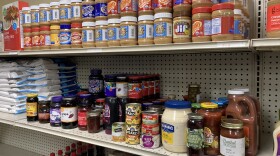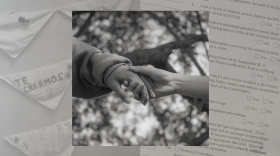
An unassuming house on Euclid Avenue, built in the late 1800s, has gotten a face lift. Inside the Bay View home, its been transformed into the Heart Haus.
According to Heart Haus' Facebook page, the space is an experiment in collaborative living, working and playing.
Its original parlor is now a digital conferencing room. It is central to the Heart Haus dream, according to Ben Koller.
Some might recognize Koller as the man who brought the Milwaukee's iconic former basketball court back into the public eye, but since last spring he has thrown himself into this project.

“The dream was we could have the technology to be able to connect partners all around the world and use the power of technology to communicate vision and connect vision,” Koller says.
Heart Haus is about experimentation and James Godsil inspired it. He contributed the building in which is stands.
Community organizing is in his blood. In 1966 in his native St. Louis, Godsil took up the mantle, which he continued to wear while raising three children on his own – in this house on Euclid - and running a roofing company.
He was central to the creation of Sweet Water Organics. It broke ground inside an old warehouse off Kinnickinnic in 2009, creating a massive aquaponics system in which fish are raised in large tanks, the water from which circulated through beds in which greens and tomatoes flourished. The business closed 2013, but Godsil’s greatest interest – Sweet Water Foundation – continues with projects and partnerships in Milwaukee and Chicago.
Godsil is known for his poetic ramblings about restoring urban economy and community through urban agriculture and aquaponics. Boomers sharing wisdom with and learning from millennials is central to his creed.
Seldom at a loss for words, Godsil is rendered nearly speechless by the energy bouncing off the walls at Heart Haus. He says retracing what led to its creation would take hours to convey.
“But I’ll just say that I was faced with a prospect of selling the house in a deferred maintenance state or taking a gamble that collaborations of what I call earth nation Americans and resourced boomers who are ready to give back and aspire to as much meaning and contribution in their final life’s chapters as is possible. And it’s been happening as you’ve discovered,” Godsil says.
Jesse Blom brings his aquaponics expertise to the Heart Haus table. He set up a small system in the Sweet Water Work Live Playroom. It contains bunk beds and a small work station.
“This small aquaponics system uses a 20-gallon aquarium tank. We’ve got three goldfish in there. And we have a little plastic box that sits above the tank and the water is pumped to the plastic box where the plants are living. This was the first thing I put in here at the Heart Haus last spring when we started the whole process, because it’s a way to engage people,” Blom says.

He created a many times larger fish and plant system in the basement stocked with tilapia, and next summer will start teaching workshops to train others to set up their own.
“Another purpose is we’re providing food for the household. The basement system was designed to produce one plant every day. So we could have one lettuce plant harvested every day. We have the capacity for about 60 plants. So if we seed every day, we can harvest every day,” Blom explains.
Heart Haus is meant to demonstrate sustainable living. Vegetable beds occupy most of its front and backyards. As time goes on, Ben Koller says they plan to add a variety of workshops.
“We’ve already done microgreen growing class, soap and detergent making and candle making,” he says.
Heart Haus aims to blend back to basics training with the latest in technology. “We hope to get a 3-D printer and CNC machine so we’re able to do rapid prototyiping and home craft development ideas,” Koller says.
In the short time since its inception, more than 1,200 people have visited – from across town to far away places like Ghana, Costa Rica and Australia – some spend a night or two.
Koller says those conversations result in great ideas. They are scribbled across white boards covering much of the dining rooms walls.
“This is probably this is the most important room. We call it the Bread Breaking Brainstorm Room, because there’s some sort of sacred energy connection that happens when you share food with people, especially food that you grew. Just naturally through conversation comes ideas. And as you can see, we’ve been working on many different things,” Koller says.

Just off the kitchen, we pop into the green room. Worms in giant tubs are quietly breaking down vegetable scraps to create soil, nearby trays overflow with microgreens and wheat grass. This is Miguel Castro’s domain.
“The development of the Heart Haus enabled me to meet and talk with people in the urban ag movement in Milwaukee and get a lot of insights. It enabled me to synthesis some of those ideas to be able to transform this room to produce up eight salads a day,” Castro says.
Heart Haus, Ben Koller says with relish, is a Petri dish. It’s about experimentation.
One experiment, the brainchild of a guest from Central America, resides in the snow-packed backyard.
Koller describes the once highly functional hoop house as Heart Haus’ most glorified failure – to date.
“Alex Pacheco of Earth University was on sabbatical and part of his sabbatical was to do a practical. So we decided to make a hoop house for sprouting and different things in the summer and spring. Alex is from Costa Rica and he had a way of making them, so at times I said ‘Alex, I don’t think this is going to hold up’ but he was a professor and a PhD, so who was I to say it wouldn’t work,” Koller says.
They built it using materials from the neighborhood hardware store for $157.00.
Koller says it was learning experience they cherish. “And we can just unscrew this, take it apart and reuse the materials,” he says.
The team believes Heart Haus is making strides. They can feel it in the neighborhood.
Koller says last summer when heavy construction began to transform the old house, neighbors were skeptical.
“We had a huge dumpster outside the front door and as we hauled stuff out we introduced ourselves and told them we are doing this urban farm. The neighbors were cordial but nothing beyond that,” Koller says.
After it became clear to outsiders the Heart Haus crew was creating something special, Koller says they heard a knock on the door. The next door neighbor wanted to borrow a hedge trimmer.
“He had these huge shrubs along his lot line. He planted them to block his view of our backyard. He said he wanted to cut the bamboo down now because we’re neighbors now and he wants to see us,” Koller says.
Months later, after they had been harvesting and sharing vegetables from the Heart Haus garden, the neighbor returned. Ben says he asked for help removing the roots of the shrubs.
“He said you inspired us; we want to do a vegetable garden next year,” Koller says.
The team hopes Heart Haus serves as glue to pull community together that can be a model for other neighborhoods.







